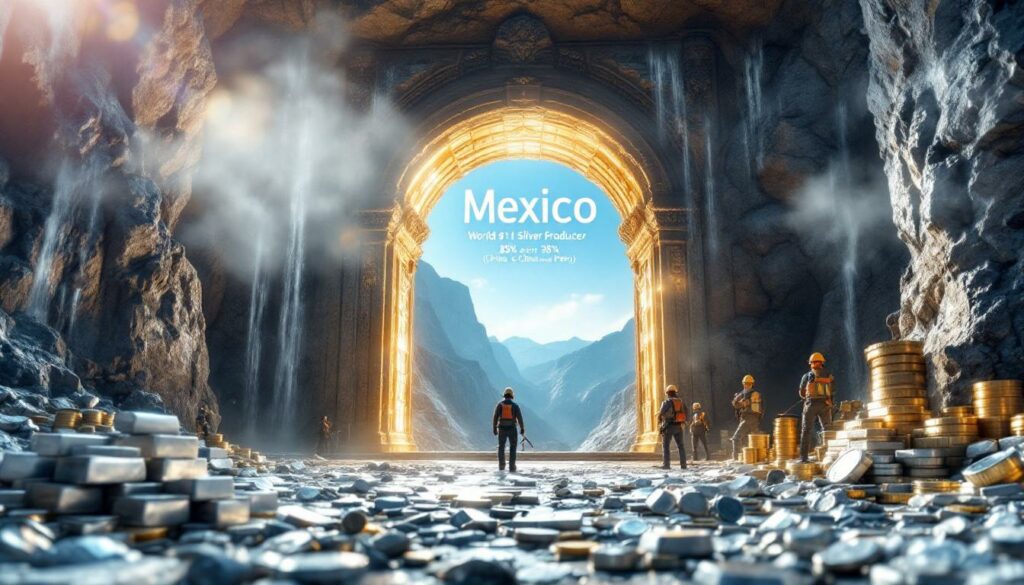How Important is Mexico to Global Silver Production?
Mexico stands as the world's leading silver producer, contributing significantly to global supply chains and maintaining a centuries-old mining tradition. The country's rich silver deposits represent a critical component of both its national economy and the global precious metals market.
As confirmed by industry leaders, "Mexico's number one in producing silver. China's number two and Peru's number three," states Dan Dixon, CEO of Endeavor Silver Corp. This dominant position has solidified Mexico's reputation as a premier mining jurisdiction for silver exploration and production.
What's particularly notable about Mexico's contribution is the quality and scale of its deposits. The country hosts multiple tier-one silver projects that feature exceptional grades and substantial resource potential, making them highly attractive to international mining companies and investors interested in silver market squeeze analysis.
Mexico's Position in Global Silver Rankings
- World's #1 producer of silver, followed by China (#2) and Peru (#3)
- Contributes approximately 23-25% of global silver mine production
- Home to multiple tier-one silver deposits with exceptional grades and scale
- Centuries of mining heritage dating back over 400 years
One fascinating aspect of global silver production is that "primary silver mines in the world's about 30% of total production comes from a primary silver mine. So they're not easy to find," explains Dan Dixon. This makes Mexico's concentration of primary silver deposits even more significant in the global landscape.
Historical Context of Mexican Silver Mining
Mexico's silver mining tradition stretches back to the Spanish colonial era, with many current mining districts built upon historical operations. The Panuco project, for example, represents a brownfield development with existing infrastructure and 400 years of mining history, according to Michael Connard, CEO of Vizsla Silver.
This long-standing relationship with silver has created:
- Deep technical expertise within the local workforce
- Well-established mining infrastructure in key regions
- Supportive regulatory frameworks specifically designed for underground silver operations
- Multigenerational mining communities with specialized skills
The combination of geological richness, historical expertise, and modern mining capabilities continues to position Mexico as the global leader in silver production in Mexico, with significant room for further growth.
What Makes Mexican Silver Deposits Unique?
The geological characteristics of Mexican silver deposits offer distinct advantages compared to other global mining jurisdictions, creating opportunities for both established producers and developers. These unique attributes have helped maintain Mexico's dominant position in global silver production despite increasing competition from other regions.
Geological Advantages
- High-grade mineralization allowing for more economical extraction
- Polymetallic nature with silver often accompanied by gold, lead, zinc, and copper
- Extensive epithermal vein systems that can extend for kilometers with consistent mineralization
- Year-round operating conditions without seasonal disruptions
This last point represents a significant competitive advantage, as Michael Connard of Vizsla Silver notes: "You're able to drill year-round in Mexico. It's not seasonal like in Canada, and that means that you can develop year-round as well." This operational continuity accelerates exploration programs and development timelines compared to jurisdictions with harsh winters or rainy seasons.
Key Silver Mining Regions in Mexico
| Region | Notable Characteristics | Major Operations |
|---|---|---|
| Sinaloa | High-grade epithermal vein systems | Panuco Project (Vizsla Silver) |
| Zacatecas | Historic silver district with multiple producers | Juanicipio Mine (MAG Silver/Fresnillo) |
| Durango | Polymetallic deposits with silver dominance | Guanaceví Mine (Endeavor Silver) |
| Chihuahua | Silver-lead-zinc mineralization | San Julián Mine (Fresnillo) |
The Sinaloa region, despite sometimes being associated with security concerns, has proven highly productive for silver exploration. Michael Connard addresses this perception-reality gap: "We're in Sinaloa, which, you know, a lot of people… they open up Netflix and you see documentaries on Chapo and Sinaloa Cartel and things like that… but it really hasn't dissuaded anyone from investing and in reality… working in Sinaloa there's a huge difference between perception and reality."
Mexican silver deposits also benefit from established mining codes and regulatory frameworks specifically designed for underground operations, which typically face fewer permitting hurdles than open-pit projects. This regulatory environment, combined with the geological advantages, creates a favorable jurisdiction for silver-focused mining companies.
How Does Mexican Silver Mining Contribute to the Economy?
Silver production represents a significant economic driver for Mexico, generating substantial employment, tax revenue, and foreign investment opportunities. The industry's impact extends well beyond direct mining operations, creating ripple effects throughout local economies and supporting communities across multiple states.
Economic Impact Statistics
- Thousands of direct jobs created in mining operations
- Tens of thousands of indirect jobs in supporting industries
- Billions in foreign investment for exploration and development
- Export revenue strengthening Mexico's trade balance
While specific government statistics on employment and tax revenue aren't provided in the source material, industry leaders consistently emphasize the significant economic contributions of silver mining operations. Both Endeavor Silver and Vizsla Silver, for example, highlight their commitment to local economic development through their operations.
Community Development Initiatives
Modern silver mining companies in Mexico typically implement:
- Local workforce development programs
- Infrastructure improvements in mining communities
- Educational partnerships with technical schools
- Environmental stewardship programs
These initiatives represent a significant evolution in how mining companies operate in Mexico. Rather than simply extracting resources, leading companies now view community development as an essential component of their business model. This approach creates sustainable economic benefits while securing social license to operate.
The economic impact of silver mining is particularly significant in rural regions where alternative employment opportunities may be limited. Mining operations often become the economic anchor for entire communities, providing stable, well-paying jobs and supporting local businesses through procurement and services.
As silver prices have recently approached the $40 mark (reaching $39.90 according to Michael Connard), the economic contribution of Mexico's silver industry is poised to increase further, potentially driving additional investment and development in key mining regions.
What Challenges Face Silver Production in Mexico?
Despite its advantages, silver mining in Mexico faces several operational and regulatory challenges that companies must navigate. Understanding these challenges is essential for investors and industry participants to realistically assess project timelines and potential obstacles.
Operational Considerations
- Security concerns in certain regions requiring specialized protocols
- Water management in arid mining districts
- Power infrastructure development for remote operations
- Skilled labor competition among expanding mining operations
The security perception issue, particularly in regions like Sinaloa, represents a unique challenge. However, as Michael Connard notes, the reality on the ground often differs significantly from international perceptions: "Working in Sinaloa there's a huge difference between perception and reality." Companies with established operations have developed effective security protocols that allow safe and continuous operations.
Water management presents another significant challenge, especially in Mexico's more arid regions. This has driven innovation in water conservation and recycling technologies, with companies like Endeavor Silver implementing dry stack tailings systems to reduce water consumption and environmental impact.
Regulatory Environment
- Permitting timelines for new projects typically averaging 8-9 years from discovery to production
- Environmental regulations with increasing focus on tailings management
- Community consultation requirements becoming more stringent
- Recent political transitions affecting mining policy implementation
The permitting timeline represents one of the most significant challenges for new projects. "On average in Mexico the amount of time it takes to go from discovery to production is about 8 and a half years," explains Michael Connard. This extended timeline requires significant patience and capital resources from development-stage companies.
However, there are important nuances to the permitting process. Underground mining operations typically face fewer regulatory hurdles than open-pit mines, given their smaller surface footprint and reduced environmental impact. Companies that focus on underground silver mining often benefit from more streamlined approval processes compared to large-scale open-pit operations.
The challenge of navigating Mexico's regulatory environment underscores the importance of experienced management teams with established relationships and demonstrated success in the country. Companies that understand the cultural and political context of mining in Mexico have a significant advantage in advancing projects efficiently.
Who Are the Major Players in Mexican Silver Production?
The Mexican silver landscape includes both established producers and emerging developers poised to contribute significantly to global supply. Recent years have seen increased consolidation activity as larger companies seek to acquire quality assets in this premier silver jurisdiction.
Established Producers
- Endeavor Silver Corp: Operating multiple mines with approximately 8 million silver equivalent ounces produced in 2024, targeting growth to 20 million ounces by 2026
- First Majestic Silver: Significant producer with multiple operating assets
- Pan American Silver: Major producer with diversified operations
- Fresnillo plc: Mexico's largest mining company and the world's largest silver producer
Dan Dixon of Endeavor Silver provides insight into his company's growth trajectory: "In 2024, we produce about 8 million silver equivalent ounces. Hopefully for 2026 annualized, we'll be producing 20 million silver equivalent ounces." This substantial production increase demonstrates the growth potential within established operations.
The consolidation trend in Mexican silver mining has accelerated recently, with Dixon noting that "Silver Crest, Gatau, and now Mag Silver has all got taken out within the last year, year and a half." This M&A activity reflects the strategic value of Mexican silver assets and the desire of larger companies to secure high-quality resources.
Emerging Developers
- Vizsla Silver: Developing the Panuco project, positioned to become one of the largest primary silver producers globally
- GoGold Resources: Advancing the Los Ricos project in Jalisco
- Discovery Silver: Developing the Cordero project in Chihuahua
- Other junior developers: Advancing projects through exploration and permitting stages
Vizsla Silver represents one of the most significant emerging players, with Michael Connard stating, "We'll be the largest single asset silver primary producer in the world." The company recently raised significant capital to advance its flagship project: "We just raised $100 million recently in a bot deal that brings our cash on hand to north of $200 million US."
This substantial financial position allows Vizsla to aggressively advance the Panuco project toward production without diluting shareholders through additional fundraising. According to Connard, the company expects "to be starting construction by the midpoint of next year… being in a position to produce first silver at the end of 2027."
The landscape of major players continues to evolve as projects advance from exploration to development and production stages. The strong financial backing of emerging developers like Vizsla Silver suggests that the next generation of Mexican silver producers is well-positioned to contribute significantly to global supply.
How Is Technology Transforming Mexican Silver Mining?
Modern silver mining in Mexico is increasingly adopting advanced technologies to improve efficiency, safety, and environmental performance. This technological evolution is transforming traditional mining practices and creating more sustainable operations across the industry.
Technological Innovations
- Transition from wet to dry stack tailings reducing water consumption and environmental footprint
- Underground mining automation improving safety and productivity
- Advanced metallurgical processes enhancing recovery rates
- Digital monitoring systems for real-time operational optimization
The shift from wet to dry stack tailings represents a particularly significant technological advancement. As Dan Dixon notes, "They're going from wet stack tailings to dry stack. We did that at Bonanza." This transition substantially reduces water consumption and minimizes the environmental footprint of mining operations, particularly important in water-scarce regions.
Underground mining technologies have advanced significantly, with modern operations employing sophisticated ventilation systems, mechanized drilling equipment, and enhanced ground support techniques. These technologies improve both safety and productivity while allowing access to deeper and more complex ore bodies.
Sustainability Initiatives
- Renewable energy integration at mining operations
- Water recycling systems minimizing freshwater consumption
- Progressive reclamation practices during operations
- Community-based environmental monitoring programs
The integration of sustainability initiatives with technological advancement represents a key trend in Mexican silver mining. Companies increasingly recognize that environmental and social performance directly impacts their social license to operate and their ability to attract investment.
Leading companies are implementing comprehensive water management systems that maximize recycling and minimize freshwater consumption. This approach not only reduces environmental impact but also secures operational continuity in regions where water scarcity could otherwise constrain production.
The technological transformation of Mexican silver mining demonstrates the industry's adaptability and commitment to continuous improvement. As new technologies emerge and are adopted, the efficiency and sustainability of silver production in Mexico are likely to continue improving, potentially extending mine life and expanding the economically viable resource base.
What Does the Future Hold for Mexican Silver Production?
The outlook for Mexican silver production appears robust, with several significant projects in development and favorable market conditions. Both supply and demand factors suggest a positive trajectory for the industry in the coming years.
Development Pipeline
- Multiple projects advancing from exploration to development stages
- Expansion of existing operations to increase production capacity
- Consolidation of smaller operations to achieve economies of scale
- Brownfield exploration around existing mines extending mine life
Vizsla Silver's Panuco project exemplifies the development pipeline, with Michael Connard outlining their timeline: "We expect to be starting construction by the midpoint of next year… being in a position to produce first silver at the end of 2027." Similarly, Endeavor Silver plans to more than double its production from 8 million to 20 million silver equivalent ounces by 2026.
The development timeline for new projects remains significant, with Connard noting that "Simon's estimation… we suspect that it's probably about an 18 month build, probably a little bit less, maybe closer to 16 months" once permitting is complete. This extended timeline from discovery to production (approximately 8.5 years on average) means that the project pipeline is relatively predictable.
Market Outlook Factors
- Industrial demand growth from renewable energy, electronics, and medical applications
- Investment demand influenced by monetary policy and economic uncertainty
- Supply constraints as older mines deplete reserves
- Gold-silver ratio insights potentially favoring silver price appreciation
The gold-silver ratio represents a particularly interesting market indicator. As Dan Dixon explains, "We're sitting at 88 to 1 silver to gold ratio historically that's 65 to 1. 2011… it got as low as 32 to 1." This suggests potential upside for silver prices relative to gold if the ratio reverts toward historical averages.
Recent price movements support this optimistic outlook, with Michael Connard noting that silver recently reached "$39.90 silver. You know, we're almost at that $40 mark." This price level creates substantial margins for producers and incentivizes further development and exploration.
The future of Mexican silver production will likely be characterized by both continuity and change. Established mining districts will continue to produce, potentially with expanded capacity, while new discoveries will gradually enter the production pipeline. The consolidation trend is likely to continue as larger companies seek to secure quality assets in this premier jurisdiction.
How Do Financing Trends Impact Mexican Silver Development?
The ability to secure capital for exploration, development, and operations remains critical for the Mexican silver sector. Recent trends suggest increasing investor interest in silver equities, particularly as silver prices strengthen and supply-demand fundamentals improve.
Current Financing Landscape
- Increased investor interest in silver equities as prices strengthen
- Project financing packages combining debt and equity components
- Strategic partnerships with streaming and royalty companies
- Merger and acquisition activity consolidating quality assets
Vizsla Silver's recent financing success illustrates the favorable funding environment for quality projects: "We just raised $100 million recently in a bot deal that brings our cash on hand to north of $200 million US," notes Michael Connard. This substantial treasury positions the company to advance its Panuco project without additional dilution to shareholders.
The sources of capital for Mexican silver projects continue to diversify, with Connard observing, "We absolutely did see that. We saw a large order from a US base, but basically South American sourced funds." This international interest reflects the global recognition of Mexico's importance to the silver squeeze movement.
Investor Considerations
- Production costs (AISC) typically ranging from $15-20 per ounce for primary silver producers
- Project development timelines averaging 16-18 months for construction after permitting
- Margin expansion potential as silver prices increase
- Jurisdictional advantages compared to other silver-producing regions
Current silver prices create attractive margins for producers. As Michael Connard explains, "The typical silver producer is AISC is nearing that $20 mark, you know, that that's great margin for silver producers." With silver prices approaching $40 per ounce, producers are experiencing substantial profitability, which in turn attracts additional investment.
The financing landscape for Mexican silver development reflects a broader trend of increasing investor interest in precious metals as a hedge against economic uncertainty. This trend, combined with the fundamental supply-demand dynamics of the silver market, creates a favorable environment for companies seeking to finance new projects or expand existing operations.
For investors considering the Mexican silver sector, understanding the specific economic parameters of individual projects—including capital intensity, operating costs, and development timelines—remains essential for evaluating investment opportunities effectively.
What Are the Steps from Discovery to Production in Mexico?
The pathway from initial silver discovery to commercial production in Mexico follows a well-established sequence, though timelines can vary significantly. Understanding this process is crucial for investors assessing the development potential of exploration and development-stage companies.
Typical Development Pathway
Ready to Stay Ahead of Major ASX Mining Discoveries?
Discover why major mineral discoveries can lead to significant market returns by exploring Discovery Alert's dedicated discoveries page, where real-time alerts powered by the proprietary Discovery IQ model provide an immediate market edge for both new and experienced investors.




